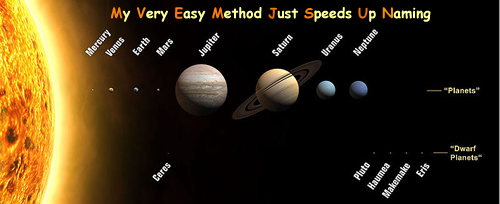The Solar System
 A star system consists of the star and everything bound to that star by gravity.
A star system consists of the star and everything bound to that star by gravity.
 Our star is the Sun - it's name is 'Sol' - so it has a solar system.
Our star is the Sun - it's name is 'Sol' - so it has a solar system.
 Current theory says that the system formed from the collapse of a giant molecular cloud approximately 4.6 billion years ago.
Current theory says that the system formed from the collapse of a giant molecular cloud approximately 4.6 billion years ago.
 There are many objects that orbit the Sun but most of the mass is contained within the eight planets.
There are many objects that orbit the Sun but most of the mass is contained within the eight planets.
 The orbits of the planets are almost circular and lie within a virtually flat disc area called the ecliptic plane.
The orbits of the planets are almost circular and lie within a virtually flat disc area called the ecliptic plane.
 The four smaller inner planets (sometimes called the Terrestrial planets): Mercury, Venus, Earth and Mars, are mainly made up of rock and metal. They are quite dense.
The four smaller inner planets (sometimes called the Terrestrial planets): Mercury, Venus, Earth and Mars, are mainly made up of rock and metal. They are quite dense.
 The four outer planets, the gas giants, are substantially more massive than the terrestrials.
The four outer planets, the gas giants, are substantially more massive than the terrestrials.
 The two largest planets, Jupiter and Saturn, are composed mainly of hydrogen and helium - which are in a gas form on Earth but are mainly in the liquid form on the planets as the temperature is so cold.
The two largest planets, Jupiter and Saturn, are composed mainly of hydrogen and helium - which are in a gas form on Earth but are mainly in the liquid form on the planets as the temperature is so cold.
 The two outermost planets, Uranus and Neptune, are composed largely of ices, such as water, ammonia and methane, and are often referred to separately as "ice giants".
The two outermost planets, Uranus and Neptune, are composed largely of ices, such as water, ammonia and methane, and are often referred to separately as "ice giants".

 The Solar System is also home to two regions populated by smaller objects.
The Solar System is also home to two regions populated by smaller objects.
 The asteroid belt, which lies between Mars and Jupiter, has an abundance of asteroids composed mainly of rock and metal.
The asteroid belt, which lies between Mars and Jupiter, has an abundance of asteroids composed mainly of rock and metal.
 Beyond Neptune's orbit lie trans-Neptunian objects composed mostly of ices such as water, ammonia and methane.
Within these two regions, five individual objects, Ceres, Pluto, Haume, Makemake and Eris, are recognized to be large enough to have been turned into spehrical shapes by their own gravity, we therefore call them dwarf planets.
Beyond Neptune's orbit lie trans-Neptunian objects composed mostly of ices such as water, ammonia and methane.
Within these two regions, five individual objects, Ceres, Pluto, Haume, Makemake and Eris, are recognized to be large enough to have been turned into spehrical shapes by their own gravity, we therefore call them dwarf planets.
 There are thousands of small bodies orbiting the Sun. In addition to the planets and asteroids there are comets, centaurs and interplanetary dust and satellites (or moons) orbiting the larger bodies.
There are thousands of small bodies orbiting the Sun. In addition to the planets and asteroids there are comets, centaurs and interplanetary dust and satellites (or moons) orbiting the larger bodies.
 It is a busy thoroughfare out there!
It is a busy thoroughfare out there!
This information was extracted from Wikipedia (November 2010)
Need more info?



